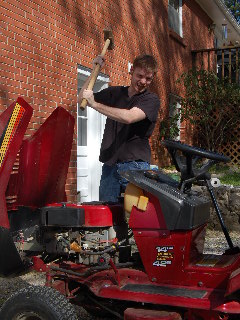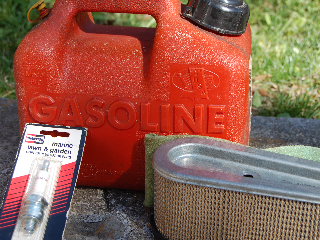
Years ago, while working a summer job doing grounds maintenance on the local municipal golf course, I quickly learned that part of the job involved working on the equipment that was used to work on the grounds.
One of my co-workers, a guy named Jerry, had no patience at all with equipment breakdowns and the necessary repairs.
If a mower wouldn’t start with just a couple of tries, Jerry’s suggested solution was always, “Get the big hammer!”
A mower that won’t start can be a real nuisance.
Banging on it with a big hammer might ease your frustration, but it won’t solve the problem.
So, let’s take a quick look at some basics in order to get you and your mower fired up.
And speaking of fire, do you remember your general science lesson from probably around the third or fourth grade about the “Fire Triangle?”
Sure you do—the three things needed to start a fire are: fuel, spark, and oxygen.
It’s the same with your lawnmower’s internal combustion engine—fuel(as in gasoline), spark(as in spark plug), and oxygen(as in clean air) are the ingredients that put the power into your power mower.
So, go ahead with the first and easiest step in evaluating your mower’s silence—check the fuel tank to be sure it contains plenty of clean fresh gasoline. (I hope you have a good gas can with some sort of mesh screening in or on the pour-spout that keeps debris from getting into your fuel tank).

If there’s plenty of gas in the tank, then pull the starter cord a couple of times or turn the key if it’s an electric (battery-powered) starter. This will let the engine turn over enough that it should be sending fuel to the spark plug.
Now, remove the spark plug and see if the end you just removed (the spark gap area) is wet with gasoline. If it isn’t, the gas line may be clogged with grit or grunge—remove both ends of the gas line and clean it out before re-installing.
Step two--if the spark plug is wet when you check it, gas is getting to it, but the plug isn’t firing. Either the plug is faulty or too dirty to fire, or there is not enough clean air getting in to complete the fire triangle.
Install a new spark plug if you have one; if you don’t, clean the blackened area in and around the spark gap with fine sandpaper.
On to the third step—remove the air filter and check to see if it is clean and relatively free of dust, fine clippings, or general grunge. Sometimes, the filter (or spongy pre-filter) can become so dirty that the air is actually blocked from passing through it. This is one of the most common causes of a mower not starting. A dirty air filter is often the problem also when a mower is "sputtering" rather than firing cleanly.
Now, attempt to start the mower while the air filter is still removed. If it fires, this will tell you the filter is the problem. Suggested therapy is the same as with the spark plug—replace it if possible, otherwise clean it thoroughly.
This checklist is designed primarily for smaller engine, walk-behind, recoil starter mowers. If you have a riding mower with a battery-powered starter, other electrical problems might be occurring to keep your mower from starting. Be sure the battery has a good charge, the battery post connections are clean, and all the wires are connected properly. If your mower still has no fire, the issues will probably need to be addressed by a professional service center.
Whatever you do, don’t get so frustrated that you “Get the big hammer!”
 Years ago, while working a summer job doing grounds maintenance on the local municipal golf course, I quickly learned that part of the job involved working on the equipment that was used to work on the grounds.
Years ago, while working a summer job doing grounds maintenance on the local municipal golf course, I quickly learned that part of the job involved working on the equipment that was used to work on the grounds.
 If there’s plenty of gas in the tank, then pull the starter cord a couple of times or turn the key if it’s an electric (battery-powered) starter. This will let the engine turn over enough that it should be sending fuel to the spark plug.
If there’s plenty of gas in the tank, then pull the starter cord a couple of times or turn the key if it’s an electric (battery-powered) starter. This will let the engine turn over enough that it should be sending fuel to the spark plug.